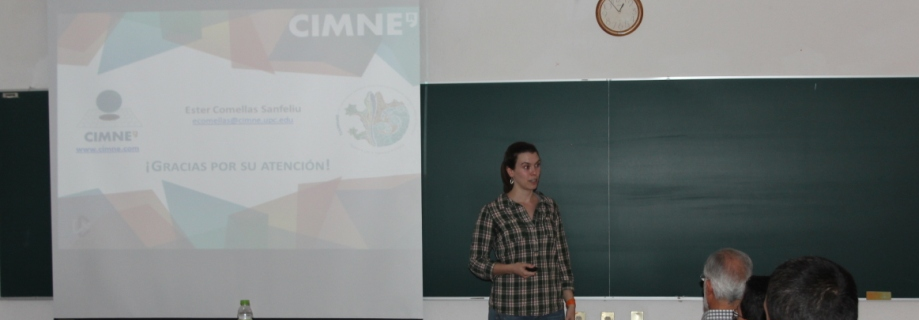
First scientific outputs of TCAiNMaND is available
Ester Comellas, a PhD candidate in CIMNE supervised by Professor Sergio Oller successfully completed the first secondment of the TCAiNMaND project in CIMAT, under supervision of Professor Salvador Botello.
During the Computational Sciences Seminar of CIMAT held on March 28th, Ms. Comellas described the work performed during her stay. Working with CIMAT’s PhD candidate Miguel Vargas-Felix, they successfully developed a modification of a program which adjusts the material parameters of a damaged structure made of composite material. This program couples the optimization program OPTIMATE, developed by Dr. Ivvan Valdez in CIMAT, to the Finite Element code PLCd, which is developed by Prof. Oller’s group in CIMNE. The program they have been working on, manages to give an experimentally obtained force-displacement curve, adjust the material properties of a Finite Element model which gives as a result the desired curve. This program will aid in the evaluation of the damage caused on structures by natural disasters such as earthquakes and flooding, and, thus, assist in the design of safer buildings.
In addition, Ms. Comellas and Mr. Vargas-Felix managed to successfully parallelize the PLCd code, reducing calculation time to one fourth of the time for the non-parallelized version, when applied to an FE problem. PLCd is a complex code which will require future restructuration in order to further improve the computing time and reduce the memory usage. It is expected that these improvements will allow the FE simulation of entire buildings in the future. CIMNE researcher Cuauhtemoc Escudero will be developing this task during the next secondment in CIMAT, starting in May.
During her six-week long stay in CIMAT, Ms. Comellas has been able to work with a CIMAT’s numerical methods andoptimization group, led by Prof. Botello and composed by researchers Arturo Hernández, Ivvan Valdez and Miguel Vargas-Felix. The aim of the group for this collaboration is to implement an application which uses high performance computing resources for minimizing the error between the experimental data and simulated data, by finding the best simulation parameters. As a consequence, once we known the simulation parameters, we will be capable of accurately quantify the damage as well as predicting the behavior of the simulated structure under different scenarios.
The Numerical Methods and Optimization Group at CIMAT, is one of the three research groups in Computer Sciences. The areas of interest of the group are: evolutionary computation, estimation of distribution algorithms, multiobjective optimization, parallel and distributed computing, numerical methods, and industrial solutions mainly related with numerical optimization and numerical methods in engineering. The group has developed optimization tools which can distribute the computational work to several processes and processors, in order to reduce the computational time.
For more information, please contact:
Susana Montalvo at infotcainmand@cimat.mx
More sites to visit about the event are:
http://zonafranca.mx/el-cimat-y-el-cimne-desarrollan-metodos-innovadores-para-la-simulacion-de-materiales/
http://www.eslocotidiano.com/articulo/ciencia-educacion/innova-cimat-simulacion-materiales/201404010431028720.html
http://www.periodicocorreo.com.mx/guanajuato/150471-cimat-busca-construir-edificios-mas-seguros.htmlhttp://am.com.mx/guanajuato/local/por-la-seguridad-97400.html